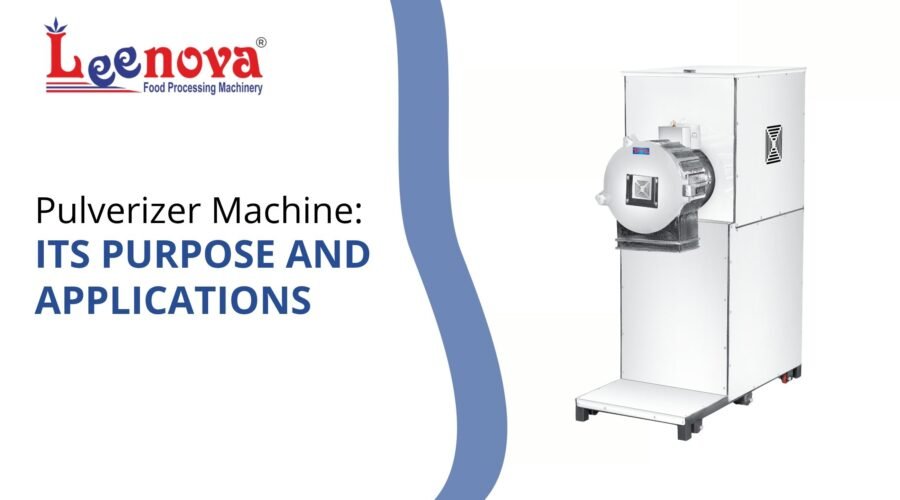Commercial kitchens waste nearly 40% of raw materials when grinding spices, grains, and herbs manually. A pulverizer machine solves that problem. It transforms coarse materials into fine, uniform powders faster and more efficiently than any manual method. As a manufacturer of food processing equipment since 2006, we understand what businesses need from grinding equipment. This guide explains what pulverizer machines are, how they work, the industries that rely on them, and how to select the right one for specific needs.
What Is a Pulverizer Machine?
A pulverizer machine is a mechanical device designed to reduce solid materials into fine powder through crushing and grinding. The machine uses motor-driven rotating blades or discs to break down materials into particles of consistent size.
Most pulverizers operate on a simple principle. Material enters through a feed hopper, meets high-speed rotating components, and gets reduced to powder form through repeated impact and friction. The output size depends on the screen mesh installed.
Food processing pulverizers handle both dry and semi-moist ingredients. They grind spices, grains, dried herbs, nuts, sugar, and similar products into powders ranging from coarse to ultra-fine texture.
Types of Pulverizer Machines
Impact Pulverizers
Impact pulverizers use high-speed rotating hammers to strike materials repeatedly. Each collision breaks particles down further until they pass through the screen mesh. These machines handle tough, fibrous materials effectively.
Disc Pulverizers
Disc pulverizers feature two rotating discs that grind materials between their surfaces. The gap between discs determines particle size. This design produces uniform powder and works well with grains and spices.
2-in-1 Pulverizers
The 2-in-1 design combines wet and dry grinding capabilities in one unit. Users switch between functions without changing equipment. This versatility makes it popular in commercial food preparation.
How Pulverizer Machines Work?
The working mechanism starts with material feeding. Ingredients enter the grinding chamber through a hopper, where gravity pulls them toward rotating components. The rotation speed ranges from 1440 to 2880 RPM depending on motor horsepower.
Rotating blades or discs strike the material with force. Each impact breaks particles into smaller pieces. The process continues until particles become fine enough to pass through the screen mesh installed at the chamber base.
Screen mesh size controls output fineness. A 20-mesh screen produces coarser powder; an 80-mesh screen creates ultra-fine powder. The ground material exits through a discharge outlet, ready for packaging or further processing.
Applications Across Industries
Food Processing
Food processing relies heavily on pulverizers. Restaurants use them to grind fresh spices daily, preserving flavor and aroma better than pre-ground alternatives. Bakeries pulverize sugar, dried fruits, and nuts for cake mixes and confectionery.
Flour mills convert wheat, rice, and millets into flour at capacities ranging from 10 to 50 kg/hour. Masala manufacturers grind turmeric, chili, coriander, and complex spice blends at commercial scale.
Herbal product manufacturers process dried leaves, roots, and bark into fine powders for tea, supplements, and ayurvedic medicines.
Industrial Applications
Chemical processing plants use pulverizers to reduce raw materials to precise particle sizes. Mining operations crush ores and minerals before extraction processes.
Pharmaceutical manufacturers require ultra-fine powders for tablets and capsules. Coal-fired power plants pulverize coal into dust for efficient combustion. Plastic recycling facilities grind waste plastic into powder for reuse in manufacturing.
Market Growth and Industry Trends
The global industrial pulverizer market reached $2.5 billion in 2025 and projects growth to $3.7 billion by 2033 at a 5% CAGR. Demand increases as industries prioritize energy efficiency and precise particle size control.
Stainless steel pulverizers specifically grew to $1,169 million in 2025, driven by food processing and pharmaceutical sectors requiring hygienic equipment. The 3.9% CAGR reflects steady expansion through 2033.
Asia-Pacific markets show the strongest growth potential. Rapid industrialization in India and China creates demand for food processing equipment as commercial kitchen infrastructure expands.
Selecting the Right Pulverizer
Capacity Requirements
Capacity determines which motor horsepower suits the operation. A 1 HP pulverizer handles 10-15 kg/hour, suitable for small restaurants. A 2 HP model processes 35-40 kg/hour for mid-sized operations. A 3 HP unit grinds 50+ kg/hour for commercial production facilities.
Match capacity to actual usage patterns. Overbuying wastes money; underbuying creates bottlenecks.
Material Considerations
Stainless steel construction costs more but offers corrosion resistance and food-grade hygiene. Mild steel (MS) pulverizers cost less and work fine for dry spices in controlled environments.
Chamber size matters for different materials. A 6-inch chamber suits fine spices; larger chambers handle nuts, dried fruits, and coarser ingredients.
Power and Efficiency
Single-phase motors run on standard 220V household power, convenient for small businesses. Three-phase motors deliver more power and efficiency for high-volume operations but require industrial electrical setup.
Energy consumption impacts operating costs. Modern pulverizers consume 0.75-1 kWh per hour, translating to minimal electricity expense even with daily use.
Advantages of Commercial Pulverizers
Pulverizers deliver consistent particle size that manual grinding cannot match. Uniformity improves product quality in food preparation and manufacturing processes.
Time efficiency transforms operations. What takes 30 minutes manually happens in 3-4 minutes with a pulverizer. Labor cost savings accumulate quickly in commercial settings.
Freshly ground spices retain volatile oils that provide superior aroma and flavor. Pre-ground powders lose potency during storage. In-house grinding preserves quality that customers notice.
Versatility extends equipment utility. One machine grinds multiple products—spices, grains, herbs, nuts, sugar—eliminating the need for separate grinders.
Maintenance and Operational Tips
Clean the grinding chamber after each material type to prevent cross-contamination. Brush out residue and wipe surfaces with food-grade sanitizer.
Check screen mesh weekly for tears or clogs. Damaged screens produce inconsistent particle size and reduce efficiency. Replace worn screens immediately.
Lubricate motor bearings monthly according to manufacturer specifications. Proper lubrication extends motor life and prevents breakdowns during peak operations.
Feed material steadily, not in large batches. Overloading strains the motor and produces uneven grinding. Controlled feeding optimizes output quality.
FAQs
Q: What materials can food pulverizers process?
A: Food pulverizers handle dry spices, grains, dried herbs, nuts, sugar, salt, dehydrated vegetables, coffee beans, and similar dry or semi-dry ingredients. They are not designed for wet or oily materials unless specified as 2-in-1 wet-dry models.
Q: How fine can pulverizers grind materials?
A: Fineness depends on screen mesh size. A 20-mesh produces coarse powder around 850 microns. An 80-mesh creates ultra-fine powder around 180 microns, suitable for most commercial applications.
Q: What is the difference between single-phase and three-phase pulverizers?
A: Single-phase pulverizers run on standard 220V household power, making them accessible for small businesses. Three-phase models require industrial 440V supply but deliver more power and efficiency for high-volume operations.
Q: How long do pulverizer machines typically last?
A: With proper maintenance, commercial pulverizers last 8-12 years. Stainless steel models often outlast mild steel versions. Regular cleaning, bearing lubrication, and timely screen replacement extend equipment lifespan significantly.
Q: Can pulverizers handle both small batches and continuous operation?
A: Yes. Batch processing suits varying recipes and small quantities. Continuous operation works for large-volume production. Most commercial pulverizers handle both modes depending on feeding patterns and capacity.
Conclusion
A pulverizer machine transforms raw materials into consistent, fine powders that manual methods cannot match. The right equipment improves product quality, reduces labor costs, and increases operational efficiency across food processing, manufacturing, and industrial applications.
Leenova Kitchen Equipments has manufactured food processing pulverizers since 2006, serving restaurants, commercial kitchens, and food production facilities across India. Our pulverizer machines combine stainless steel construction, precise grinding capability, and reliable motor performance to deliver consistent results batch after batch.
Whether grinding spices at 10 kg/hour or processing grains at 50 kg/hour, we build equipment that matches specific operational needs. ISO certified and CE compliant, our machines meet international quality standards while remaining accessible to businesses of all sizes.
Ready to upgrade from manual grinding? Explore our complete range of pulverizer machines designed for food processing excellence. Contact Leenova Kitchen Equipment today to find the right solution for your business.


